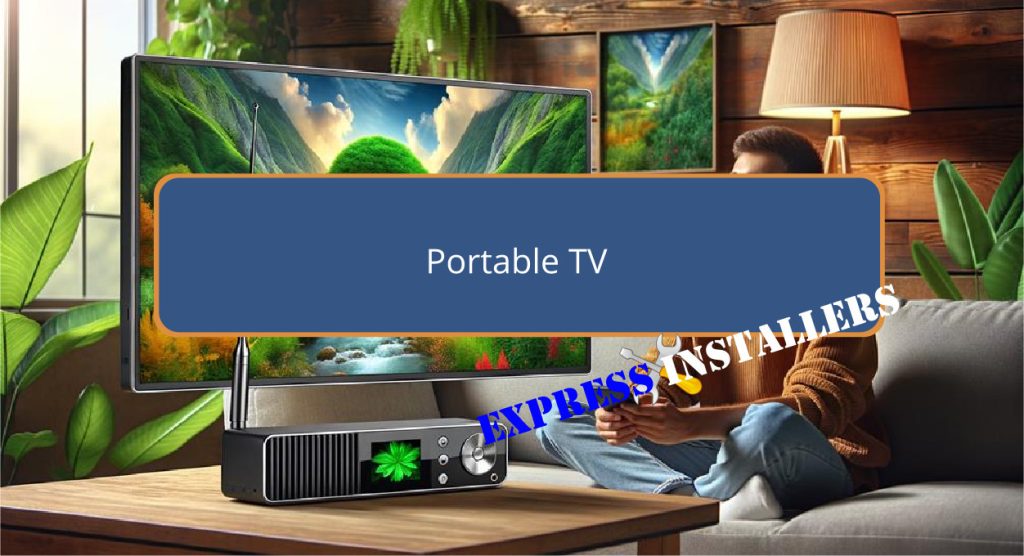
Portable TVs have evolved from the cumbersome CRT designs to sleek, efficient models utilising LCD and OLED technology.
These modern units feature high-resolution displays, improved contrast, and superior colour accuracy, which enhance the viewer experience.
Updates in signal reception coupled with advanced digital tuners have greatly enhanced access even in remote locations, bypassing older anal0og limitations.
Connectivity has expanded, incorporating HDMI, USB, and Bluetooth options, providing flexibility in media consumption.
Battery advancements allow for extended usage, facilitating prolonged entertainment without constant recharging.
Importantly, the choice between models often relies on balancing screen size with desired portability, reflecting a user’s lifestyle and consumption habits.
For insightful guidelines on selection, further exploration will prove beneficial.
Quick Summary
- Portable TVs feature advanced display technologies like OLED and 4K for superior brightness and color accuracy.
- They include improved digital tuners and antennas for stable and clear reception in various locations.
- Models offer connectivity options such as HDMI, USB, and Bluetooth, enhancing multimedia versatility.
- Lightweight, slim designs and extended battery life make these TVs ideal for travel and on-the-go entertainment.
- Future trends in portable TVs focus on seamless streaming capabilities and enhanced connectivity with technologies like 5G.
Understanding Portable TVs

Exploring the evolution of portable TVs reveals a notable transformation in design, technology, and consumer usability.
From bulky, battery-powered units to sleek, modern devices with advanced digital capabilities.
Initially, screen durability was a major concern, with earlier models featuring heavy, fragile CRT screens that were prone to damage during transport.
Contemporary portable TVs, however, utilise robust LCD or OLED screens that not only withstand rough handling but also provide superior picture quality.
Similarly, signal reception has dramatically improved. Early portable TVs struggled with inconsistent analog signals, leading to poor image quality and limited channel access.
Modern versions are equipped with enhanced digital tuners and antennas that ensure stable and clear reception, even in less accessible areas, greatly enhancing viewer experience.
Key Features Explained
Building on the technological advancements discussed, it is important to examine the key features that define modern portable TVs and distinguish them from earlier models.
- Display Technology: Modern portable TVs often feature advanced display technologies such as OLED or 4K resolution, offering superior brightness, contrast, and colour accuracy compared to the LCD screens mainly used in older models.
- Connectivity Options: Enhanced connectivity is a hallmark of contemporary portable TVs. These devices typically support a range of options including HDMI, USB, and Bluetooth, facilitating easy integration with other devices.
- Battery Life: Extended battery life is essential. Modern units provide several hours of playback on a single charge, a significant improvement over previous versions.
- Design and Portability: Current models are not only lighter but also feature slim, robust designs for enhanced portability and durability.
Benefits of On-the-Go Entertainment

Portable TV technology greatly enhances the user experience by offering entertainment flexibility that adapts seamlessly to varying environments and individual schedules.
This technology exemplifies travel convenience, allowing users to enjoy their favourite shows and movies whether they are commuting, vacationing, or simply moving from one room to another.
Compared to traditional home entertainment systems, portable TVs cater to the fast-paced nature of modern life by providing a constant access point to a wide variety of entertainment.
This is particularly advantageous for those with unpredictable or demanding schedules.
Additionally, the diversity in content availability means that users are less likely to face the monotony often associated with fixed-location viewing, making every viewing experience both unique and personal.
Top Portable TV Models
Several top models of portable TVs stand out in the market, each offering unique features that cater to diverse consumer needs and preferences.
Here is an analytical comparison of their key attributes:
- Model A: Features the highest screen resolution of 1080p, ideal for crisp, clear images. However, it has limited connectivity options with only HDMI support.
- Model B: Offers a robust 720p screen resolution and extensive connectivity, including Wi-Fi, Bluetooth, and USB ports, making it highly versatile.
- Model C: Balances between performance and portability with an 800p resolution and includes both HDMI and VGA ports.
- Model D: Focuses on long battery life with a moderate 720p screen resolution, supplemented by HDMI and built-in wireless connectivity for streaming.
Each model caters to specific preferences, prioritising either visual quality or connectivity enhancements.
Buying Guide for Portable TVs

Having explored various models, it is crucial to take into account specific factors when purchasing a portable TV to guarantee it meets your individual needs and preferences.
Screen size greatly influences portability and viewing experience. Smaller screens are more compact and easier to transport, ideal for personal use in tight spaces.
Conversely, larger screens provide a better viewing experience but can compromise portability due to increased weight and size.
Signal reception is another crucial criterion; it determines the clarity and reliability of the broadcast. Portable TVs with enhanced signal reception capabilities ensure uninterrupted viewing, particularly in areas with weak signals.
Comparatively, models with poor reception might offer a frustrating user experience, plagued by frequent signal losses and interference.
Setup and Installation Tips
To optimise the performance of your portable TV, careful consideration of the setup and installation process is crucial. Here are key steps to follow:
- Location Selection: Choose a location with minimal obstructions to enhance signal reception. Comparatively, areas near large metal surfaces or appliances can degrade signal quality.
- Antenna Adjustment: Experiment with different antenna positions to find the best angle for channel tuning. Unlike fixed TVs, portable units often require manual adjustment to optimise signal reception.
- Power Source Setup: Make sure the power source is stable and suitable for your device to prevent any electrical interference which can disrupt channel tuning.
- Initial Channel Scan: Conduct a thorough channel scan to identify all available channels. This process varies slightly between models but is crucial for maximising the content accessibility and quality.
Battery Life and Efficiency

Once the setup and installation of your portable TV are complete, focusing on battery life and efficiency becomes paramount to guarantee peak performance and longevity.
Modern portable TVs incorporate various charging methods, each with distinct advantages. For instance, USB-C charging supports faster power delivery compared to traditional micro-USB.
Similarly, energy saving modes can greatly extend battery life by adjusting screen brightness and minimising power consumption when the TV is not in active use.
| Feature | Benefits |
|---|---|
| USB-C Charging | Faster charging, more efficient |
| Micro-USB Charging | Wider availability |
| Energy Saving Modes | Extends battery life |
Analysing these features shows that choosing the right combination can enhance your viewing experience by ensuring your device remains powered longer and is ready for use whenever needed.
Portable TV Accessories
Exploring the range of accessories for portable TVs reveals significant differences in usability, portability, and overall user experience. Here we analyse the key accessories:
- Protective Cases: Essential for safeguarding the device, protective cases vary widely in material and design. Hard-shell cases offer robust protection but can add significant weight, while soft cases provide lighter, more flexible coverage.
- External Speakers: Enhancing audio output is critical for enjoyment, especially in noisy environments. The quality and connectivity options can greatly affect performance.
- Mounting Solutions: These include both temporary and permanent fixtures. The choice impacts the viewing angle and stability.
- Carrying Handles/Straps: These improve portability but must balance comfort with durability.
Maintenance and Care

Proper maintenance and care extend the lifespan of portable TVs, necessitating regular cleaning, careful handling, and adherence to manufacturer guidelines to prevent damage and preserve functionality.
Important cleaning routines are vital; employing microfiber cloths and appropriate cleansers can prevent screen scratches and damage to sensitive components.
Comparative analysis with traditional television sets reveals that portable TVs often require more frequent cleaning due to their exposure during transport.
Additionally, accessibility to specialised repair services is essential.
Unlike larger TVs, portable models may necessitate more specialised technical support to address unique operational challenges, such as battery and portability-related issues.
Ensuring access to these services greatly enhances the longevity and performance of portable TVs, underscoring the critical role of targeted maintenance practices.
Future Trends in Portable TVs
As technology advances, portable TVs are expected to undergo substantial transformations, incorporating features such as enhanced connectivity, improved battery life, and superior display technologies.
The future trends can be compared and analysed through several key developments:
- Streaming Integration: Future portable TVs will likely offer seamless streaming capabilities, allowing users to access a variety of platforms directly. This integration enhances user experience by providing diverse content on-demand.
- Advanced Display Technology: The shift towards OLED and microLED displays promises richer colors and deeper blacks, outperforming current LCD screens.
- Environmental Impact: Manufacturers are focusing on reducing the environmental footprint by using sustainable materials and improving energy efficiency.
- Enhanced Connectivity Options: With the inclusion of 5G and Wi-Fi 6, portable TVs will offer faster and more reliable internet connections, making streaming and browsing significantly smoother.
Frequently Asked Questions
Can Portable TVs Receive International Channels?
Channel compatibility and antenna strength are essential in determining whether a device can access international channels. Portable TVs, if equipped with appropriate technology and strong signal reception, can indeed receive such channels.
Are Portable TVs Safe for Children’s Prolonged Use?
Prolonged use of electronic screens can lead to eye strain and sleep disruption in children. It is recommended to limit exposure and incorporate periodic breaks to mitigate potential negative health effects.
How Do Portable TVs Handle Extreme Temperatures?
Portable devices typically exhibit variable thermal performance, depending on their design and materials used. Their temperature resilience can differ notably, with some handling extreme temperatures better than others through enhanced cooling systems or insulation technologies.
Can Portable TVs Be Upgraded With New Technology?
Portable devices can often be enhanced through hardware modifications and software updates. However, the feasibility and effectiveness of these upgrades vary, depending primarily on the original design and compatibility with new technological advancements.
Do Portable TVs Interfere With Other Wireless Devices?
Portable devices can interfere with other wireless equipment if their signal overlaps within the same frequency spectrum. This disruption depends on the specific frequencies used and the shielding effectiveness of the involved devices.
Conclusion
To sum up, when evaluating portable TVs, it is important for consumers to take into account significant technological advancements that offer improved convenience and entertainment mobility.
A thorough analysis indicates a shift towards better battery efficiency, wider accessory compatibility, and higher display quality in leading models.
Comparative evaluations suggest that future advancements may prioritise sustainability and integration with emerging digital ecosystems.
Therefore, consumers are encouraged to carefully assess these factors, guided by detailed specifications and performance metrics, to make the most of their investment in portable television technology.
